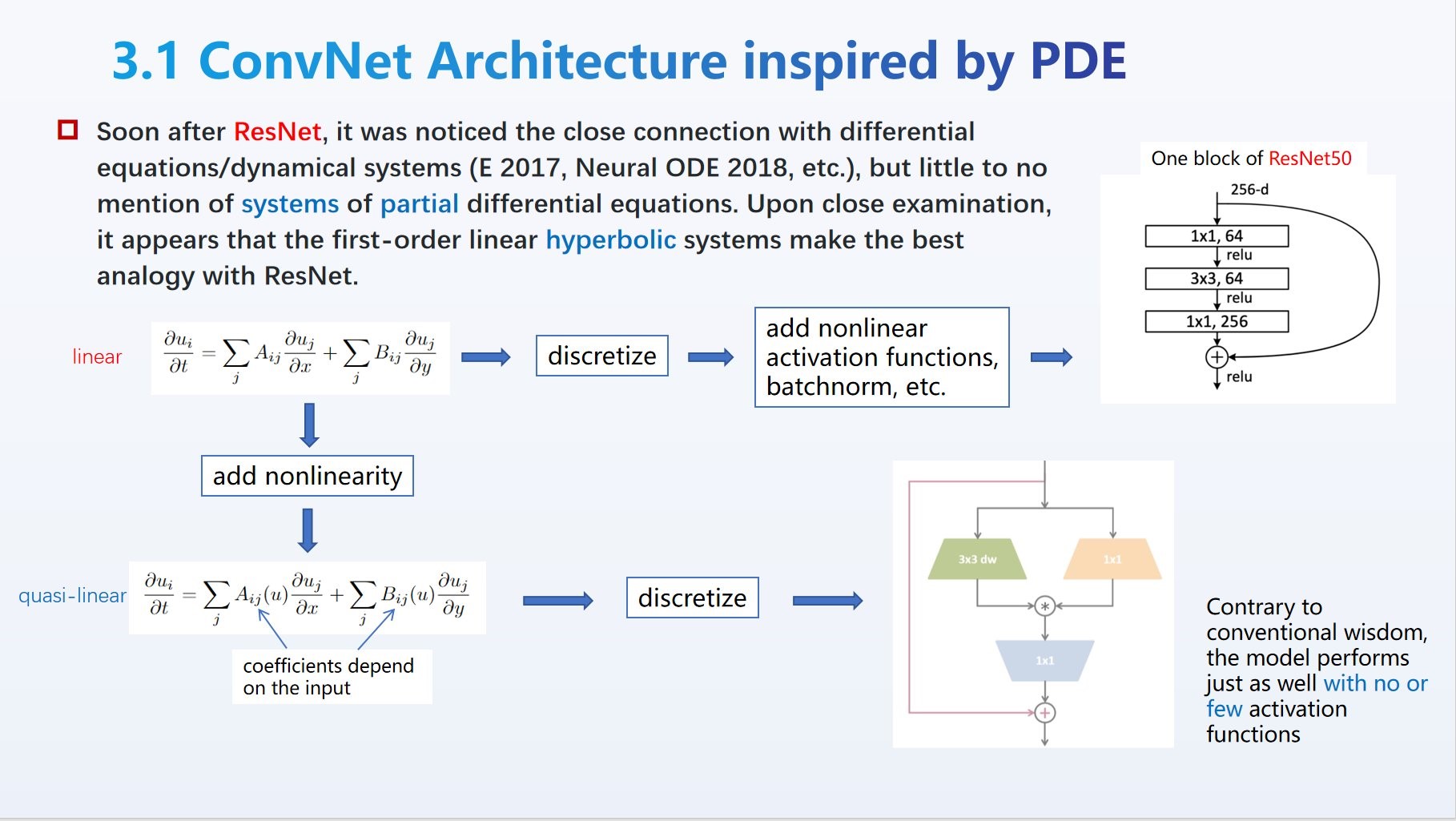|
--- |
|
datasets: |
|
- imagenet-1k |
|
library_name: timm |
|
license: apache-2.0 |
|
pipeline_tag: image-classification |
|
metrics: |
|
- accuracy |
|
tags: |
|
- PDE |
|
- ConvNet |
|
--- |
|
|
|
# Model Card for Model ID |
|
|
|
Based on a class of partial differential equations called **quasi-linear hyperbolic systems** [[Liu et al, 2023](https://github.com/liuyao12/ConvNets-PDE-perspective)], the **QLNet** breaks into uncharted waters of ConvNet model space marked by the use of (element-wise) multiplication in lieu of ReLU as the primary nonlinearity. It achieves comparable performance as ResNet50 on ImageNet-1k (acc=**78.61**), demonstrating that it has the same level of capacity/expressivity, and deserves further analysis and study (hyper-paremeter tuning, optimizer, etc.) by the academic community. |
|
|
|
The overall architecture follows that of the origianl ConvNet (LeCun) and ResNet (He et al.), with the adoption of "depthwise convolution" as in MobileNet. |
|
|
|
 |
|
|
|
One notable feature is that the architecture (trained or not) admits a *continuous* symmetry in its parameters. Check out the [notebook](https://colab.research.google.com/#fileId=https://huggingface.co/liuyao/QLNet/blob/main/QLNet_symmetry.ipynb) for a demo that makes a transformation on the weights while leaving the output *unchanged*. |
|
|
|
FAQ (as the author imagines): |
|
|
|
- **Q**: *Who needs another ConvNet, when the SOTA for ImageNet-1k is now in the low 80s with models of comparable size?* |
|
- **A**: Aside from a lack of resources to perform extensive experiments, the real answer is that the new symmetry has the potential to be exploited (as a kind of symmetry-aware optimization). The "non-activation" nonlinearity is more "natural" (coordinate independence) as in many equations in mathematics and physics. Activation (of neurons or units) is but a legacy from the early days of models inspired by *biological* neural networks. |
|
- **Q**: *Multiplication is too simple, someone must have tried it?* |
|
- **A**: Perhaps. My guess is whoever tried it soon found the model fail to train with standard ReLU. Without the conviction in the underlying PDE perspective, maybe it wasn't pushed to its limit. |
|
- **Q**: *Is it not similar to attention in Transformer?* |
|
- **A**: Yes, indeed. It's natural to wonder if the activation functions in Transformer could be removed (or reduced) while still achieve comparable performance. |
|
- **Q**: *If the parameter space has a symmetry (beyond permutations), perhaps there's redundancy in the weights.* |
|
- **A**: The transformation in our demo indeed can be used to reduce the weights from the get-go. However, there are variants of the model that admit a much larger symmetry. It is also related to the phenomenon of "flat minima" found empirically in some conventional neural networks. |
|
|
|
*This modelcard aims to be a base template for new models. It has been generated using [this raw template](https://github.com/huggingface/huggingface_hub/blob/main/src/huggingface_hub/templates/modelcard_template.md?plain=1).* |
|
|
|
|
|
## Model Details |
|
|
|
### Model Description |
|
|
|
Instead of the `bottleneck` block of ResNet50 which consists of 1x1, 3x3, 1x1 in succession, this simplest version of QLNet does a 1x1, splits into two equal halves and **multiplies** them, then applies a 3x3 (depthwise), and a 1x1, *all without activation functions* except at the end of the block, where a "radial" activation function that we call `hardball` is applied. |
|
|
|
```python |
|
class QLBlock(nn.Module): |
|
... |
|
|
|
def forward(self, x): |
|
x0 = self.skip(x) |
|
x = self.conv1(x) # 1x1 |
|
C = x.size(1) // 2 |
|
x = x[:, :C, :, :] * x[:, C:, :, :] |
|
x = self.conv2(x) # 3x3 depthwise |
|
x = self.conv3(x) # 1x1 |
|
x += x0 |
|
if self.act3 is not None: |
|
x = self.act3(x) |
|
return x |
|
``` |
|
|
|
- **Developed by:** Yao Liu 刘杳 |
|
- **Model type:** Convolutional Neural Network (ConvNet) |
|
- **License:** As academic work, it is free for all to use. |
|
- **Finetuned from model:** N/A (*trained from scratch*) |
|
|
|
### Model Sources [optional] |
|
|
|
<!-- Provide the basic links for the model. --> |
|
|
|
- **Repository:** [ConvNet from the PDE perspective](https://github.com/liuyao12/ConvNets-PDE-perspective) |
|
- **Paper:** [A Novel ConvNet Architecture with a Continuous Symmetry](https://arxiv.org/abs/2308.01621) |
|
- **Demo:** [More Information Needed] |
|
|
|
## How to Get Started with the Model |
|
|
|
Use the code below to get started with the model. |
|
|
|
```python |
|
import torch, timm |
|
from qlnet import QLNet |
|
|
|
model = QLNet() |
|
model.load_state_dict(torch.load('qlnet-10m.pth.tar')) |
|
model.eval() |
|
``` |
|
|
|
## Training Details |
|
|
|
### Training and Testing Data |
|
|
|
ImageNet-1k |
|
|
|
[More Information Needed] |
|
|
|
### Training Procedure |
|
|
|
We used the following training script in `timm` |
|
|
|
``` |
|
python3 train.py ../datasets/imagenet/ --model resnet50 --num-classes 1000 --lr 0.1 --warmup-epochs 5 --epochs 240 --weight-decay 1e-4 --sched cosine --reprob 0.4 --recount 3 --remode pixel --aa rand-m7-mstd0.5-inc1 -b 192 -j 6 --amp --dist-bn reduce |
|
``` |
|
|
|
### Results |
|
|
|
qlnet-10m: acc=78.608 |